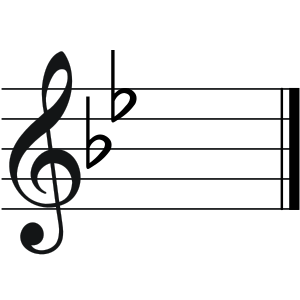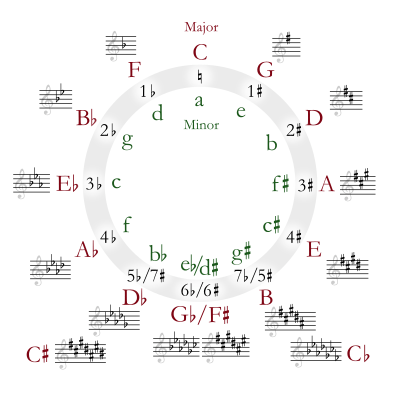Key signature facts for kids
A key signature is a special set of sharp (♯), flat (♭), or sometimes natural (♮) symbols you see at the beginning of a piece of music. These symbols are placed right after the clef on the staff.
A key signature tells you which notes should be played a little higher (sharps) or a little lower (flats) than their normal sound. This applies to all notes of that letter name throughout the music, unless a special symbol called an accidental changes it for a short time. For example, if a sharp is on the F line in the key signature, every F note in the music will be played as an F-sharp.
Every major and minor key in music has its own key signature. This signature shows which notes need to be sharp or flat to fit that key's scale. Sometimes, especially in older music, a piece might use a key signature that doesn't perfectly match its key. But usually, the key signature helps musicians know what notes to play.
Contents
How Key Signatures Work

The main reason we use key signatures is to make music easier to read. Imagine if you had to write a sharp or flat symbol next to every single note that needed to be changed! Key signatures save a lot of space and make the music look much cleaner.
The order of sharps and flats in a key signature is always the same. This helps musicians quickly figure out what key a piece is in, just by looking at how many sharps or flats there are. For example, if a key signature has only one sharp, it's always an F-sharp. This usually means the music is in G major or E minor.
Once a key signature is set at the beginning of a piece, it stays in effect until a new key signature appears. So, if there's an A-sharp in the key signature, every A note in the music will be played as an A-sharp, no matter where it is on the staff, unless an accidental changes it.
Instruments and Key Signatures
Most of the time, all the instruments in a musical piece use the same key signature. However, there are a few exceptions:
- Some instruments, like certain trumpets or horns, are called "transposing instruments." This means the notes they read are not always the same as the notes that actually sound. So, their key signatures might look different.
- Percussion instruments that don't have a specific pitch (like a drum) usually don't have a key signature.
- Sometimes, in modern music, composers might use different key signatures for different instruments if the music is polytonal. This means different parts of the music are in different keys at the same time.
The Circle of Fifths
The way key signatures are organized follows something called the Circle of fifths.
- If you start with C major (which has no sharps or flats) and move clockwise around the circle, each step adds one sharp. The new sharp is always placed on the note that is a perfect fifth higher than the last sharp.
* For example, G major has one sharp (F-sharp). D major has two sharps (F-sharp and C-sharp).
- If you move counter-clockwise from C major, each step adds one flat. The new flat is always placed on the note that is a perfect fifth lower than the last flat.
* For example, F major has one flat (B-flat). B-flat major has two flats (B-flat and E-flat).
This system creates 15 common key signatures, ranging from seven flats to seven sharps, plus the "empty" signature of C major (or A minor).
Types of Key Signatures
Key signatures are usually divided into two types: those with sharps and those with flats.
Sharp Key Signatures
Sharp key signatures can have one to seven sharps. The order of sharps is always: F, C, G, D, A, E, B. A fun way to remember this is: "Father Charles Goes Down And Ends Battle."
To find the major key from a sharp key signature, look at the last sharp. The major key is the note a half-step (or one semitone) above that last sharp.
- For example, if the last sharp is F-sharp, the key is G major.
- If the last sharp is E-sharp, the key is F-sharp major.
| Major key | Number of sharps |
Sharp notes | Minor key |
|---|---|---|---|
| C major | 0 | A minor | |
| G major | 1 | F♯ | E minor |
| D major | 2 | F♯, C♯ | B minor |
| A major | 3 | F♯, C♯, G♯ | F♯ minor |
| E major | 4 | F♯, C♯, G♯, D♯ | C♯ minor |
| B major | 5 | F♯, C♯, G♯, D♯, A♯ | G♯ minor |
| F♯ major | 6 | F♯, C♯, G♯, D♯, A♯, E♯ | D♯ minor |
| C♯ major | 7 | F♯, C♯, G♯, D♯, A♯, E♯, B♯ | A♯ minor |
Flat Key Signatures
Flat key signatures can have one to seven flats. The order of flats is the reverse of sharps: B, E, A, D, G, C, F. You can remember this by reversing the sharp mnemonic: "Battle Ends And Down Goes Charles' Father."
To find the major key from a flat key signature (except for F major, which has one flat), look at the second to last flat. That flat tells you the name of the major key.
- For example, if the key signature has four flats (B-flat, E-flat, A-flat, D-flat), the second to last flat is A-flat, so the key is A-flat major.
| Major key | Number of flats |
Flat notes | Minor key |
|---|---|---|---|
| C major | 0 | A minor | |
| F major | 1 | B♭ | D minor |
| B♭ major | 2 | B♭, E♭ | G minor |
| E♭ major | 3 | B♭, E♭, A♭ | C minor |
| A♭ major | 4 | B♭, E♭, A♭, D♭ | F minor |
| D♭ major | 5 | B♭, E♭, A♭, D♭, G♭ | B♭ minor |
| G♭ major | 6 | B♭, E♭, A♭, D♭, G♭, C♭ | E♭ minor |
| C♭ major | 7 | B♭, E♭, A♭, D♭, G♭, C♭, F♭ | A♭ minor |
Remember, a key signature is just a tool to help write and read music. It shows which notes are usually sharp or flat in a certain key, but it's not the same thing as the key itself.
Images for kids
-
Variant key signatures in a Victoria motet. In the superius (soprano) part the E♭ appears first, and in two other parts a flat occurs in two octaves.
See also
 In Spanish: Armadura (música) para niños
In Spanish: Armadura (música) para niños



